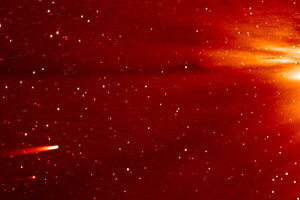Comet ISON speeds toward the sun: 'Giving us quite a ride'
There are three possible ways the comet could react to the sun's gravitational pull: it could survive, break up into chunks, or dissolve into dust. If one of the first two happens, viewers will be able to catch a glimpse.

In this frame grab, comet ISON, left, approaches the sun on Monday. ISON, which was discovered a year ago, is making its first spin around the sun and will come the closest to the super-hot solar surface on Thanksgiving Day, Thursday at 1:37 p.m. EST.
AP Photo/NASA
A comet that left the outer edge of the solar system more than 5.5 million years ago will pass close by the sun on Thursday, becoming visible in Earth's skies in the next week or two - if it survives.
"There are three possibilities when this comet rounds the sun," Donald Yeomans, manager of NASA's Near-Earth Object Program Office at the Jet Propulsion Laboratory in Pasadena, Calif., said in an interview posted on NASA's website.
"It could be tough enough to survive the passage of the sun and be a fairly bright, naked-eye object," he said.
The second possibility is that the sun's gravity could rip the comet apart, creating several big chunks.
"As long as there are pieces there, we'll see something," Carey Lisse, senior research scientist at Johns Hopkins Applied Physics Laboratory in Laurel, Md., told reporters on a conference call on Tuesday.
The third option: If the comet is very weak, it could break up into a cloud of dust and be a complete bust for viewing.
"This comet is giving us quite a ride. It's going to be hard to predict exactly what's going on," Lisse said. "As a betting man, I think it's not going to survive solar passage," he added.
Comet ISON, as the object is known, was due to pass just 730,000 miles (1.2 million km) from the surface of the sun at 1:37 p.m. EST/1837 GMT on Thursday.
At that distance, the comet will reach temperatures approaching 5,000 degrees Fahrenheit (2,760 degrees Celsius) - hot enough to vaporize not just ices in the comet's body, but dust and rock as well.
"While it may seem incredible that anything can survive this inferno, the rate at which ISON will likely lose mass is relatively small compared to the actual size of the comet's nucleus," Lowell Observatory astronomer Matthew Knight said in a NASA interview.
Scientists estimate that ISON needs to be about 219 yards (200 meters) to survive its close encounter with the sun. The most recent measurements indicate the comet is more than twice that size, and perhaps as big as .75 miles (1.2 kilometers).
It helps that ISON will not be staying in the solar furnace for long. When it zips around the sun, it will be moving at about 217 miles per second (349 km per second.)
ISON appears
The comet was discovered last year by two amateur astronomers using Russia's International Scientific Optical Network, or ISON.
It was extraordinarily bright at the time, considering its great distance beyond Jupiter's orbit, raising the prospect of a truly cosmic spectacle as it approached the sun.
Heat from the sun causes ices in a comet's body to vaporize, creating bright distinctive tails and fuzzy looking, glowing bodies. The closer comets come to the sun, the brighter they shine, depending on how much ice they contain.
Comets are believed to be frozen remains left over from the formation of the solar system some 4.5 billion years ago.
The family of comets that ISON is from resides in the Oort Cloud, which is located about 10,000 times farther away from the sun than Earth, halfway to the next star.
Occasionally, an Oort Cloud comet is gravitationally nudged out of the cloud by a passing star and into a flight path that millions of years later brings it into the inner solar system. Computer models show ISON is a first-time visitor.
"You need comets in order to build the planets and this comet has been in deep freeze in the Oort Cloud for the last 4.5 billion years," Lisse said.
"Comet ISON is a relic. It's a dinosaur bone of solar system formation," he said.
Oort Cloud comets have passed by Earth before, and sun-grazing comets are common. Comet ISON, however, is unique.
"We have never seen a comet like this, a comet that is both dynamically new from the Oort Cloud and in a sun-grazing orbit," said astrophysicist Karl Battams, with the Naval Research Laboratory in Washington.
"It has been behaving strangely," Battams said, noting recent flares and changes in brightness that could be signs the comet is fragmenting.
Regardless of what happens, "it's already been a huge victory for science," he said.
(Editing by Kevin Gray and Paul Simao)


